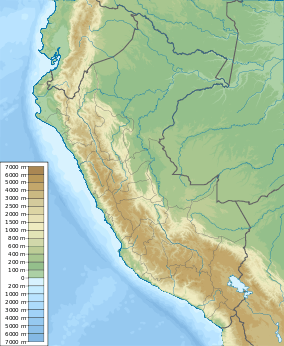Sayhuite (Saywite) is an archaeological site 47 kilometres (29 mi) east of the city Abancay in the province Abancay in the region Apurímac in Peru. The site is regarded as a centre of religious worship focusing on water.[1] An important feature on the site is the Sayhuite monolith, a rock with more than 200 geometric and zoomorphic figures. In the Monuments of the Inca by John Hemming, Hemming points to a colonial narrative that describes the interior of the Sayhuite temple. The temple featured larger columns draped in fabrics with gold bands the "thickness of one's hand." The temple was also under the care of the priestess Asarpay who jumped to her death in the nearby 400 metre gorge to avoid capture by Spanish forces.
References
External links
|
|---|
| |
- Acaray
- Arhuaturo
- Asana
- Asiru Phat'jata
- Aspero
- Awkillu Waqra
- Awkimarka
- Azángaro
- Baths of Boza
- Bandurria
- Buena Vista
- Cahuachi
- Cajamarquilla
- Cao Viejo
- Carajía
- Caral
- Caves of Sumbay
- Cerro Baúl
- Cerro Pátapo
- Cerro Trinidad
- Chan Chan
- Chankillo
- Chauchilla Cemetery
- Chavín de Huantar
- Chuqik'iraw
- Chuqi Pukyu
- Churajón
- Chuya
- Colcampata
- Cota Coca
- Cumbe Mayo
- El Brujo
- El Cañoncillo
- El Ingenio
- El Paraíso
- Garagay
- Gran Pajáten
- Gran Vilaya
- Guitarrero Cave
- Hatun Rumiyuq
- Huaca de San Marcos
- Huaca de Santa Ana
- Huaca del Dragón
- Huaca Huallamarca
- Huaca of the Moon
- Huaca of the Sun
- Huaca Prieta
- Inka Mach'ay
- Inka Raqay
- Inka Tampu, Cajamarca
- Inka Tampu, Huayopata
- Inka Tampu, Vilcabamba
- Inka Tunuwiri
- Inka Uyu
- Inka Wasi, Ayacucho
- Inka Wasi, Huancavelica
- Inka Wasi, Lima
- Inkill Tampu
- Inti Punku
- Intini Uyu Pata
- Inti Watana, Ayacucho
- Inti Watana, Písac
- Jinkiori
- Jisk'a Iru Muqu
- Kotosh
- Kuelap
- Kuntur Wasi
- Kusichaka valley
- Kutimpu
- K'anamarka
- Laguna de las Momias
- Lawriqucha
- Layzón
- Llaqtapata
- Machu Pikchu
- Mameria
- Marayniyuq
- Markansaya
- Markawamachuku
- Mawk'allaqta, Castilla
- Mawk'allaqta, Espinar
- Mawk'allaqta, La Unión
- Mawk'allaqta, Melgar
- Mawk'allaqta, Paruro
- Mawk'allaqta, Sandia
- Mayqu Amaya
- Mazur
- Mikulla
- Mirq'imarka
- Mulluqu
- Muray
- Miraflores
- Muyuq Marka
- Nazca Lines
- Ninamarka
- Ñawpallaqta
- Ñusta Hisp'ana
- Pachakamaq
- Pacatnamu
- Paiján
- Pañamarka
- Paracas Candelabra
- Patallaqta
- Phiruru
- Pikillaqta
- Pikimach'ay
- Pinkuylluna
- Pirqa Pirqa
- P'isaq
- Pucará del Cerro Mauco
- Puka Pukara
- Pukara
- Pukllana
- Pumamarka, San Sebastián
- Pumamarka, Urubamba
- Pumaq Hirka
- Punkuri
- Puruchuco
- Pusharo
- Phuyupatamarka
- Qillqatani
- Qillqa
- Qillqay Mach'ay
- Quiaca
- Qulu Qulu
- Qunchamarka
- Qurikancha
- Qurimarka, Apurímac
- Qurimarka, Cusco
- Quriwayrachina
- Q'inqu
- Q'inq'u
- Raimondi Stele
- Raqch'i
- Revash
- Rumiqullqa
- Rumiwasi
- Runkuraqay
- Saksaywaman
- Sayaqmarka
- Sayhuite
- Sechin
- Sillustani
- Sipán
- Suntur
- Tambo Colorado
- Tambo Totem
- Tampu Mach'ay
- Tanqa Tanqa
- Tantarica
- Taqrachullu
- Tarawasi
- Tarmatampu
- Tipón
- Titiqaqa
- Toquepala Caves
- Toro Muerto
- Trinchera Fortress
- Túcume
- Tunanmarka
- Tunay Q'asa
- Tupu Inka
- Uchkus Inkañan
- Ullantaytampu
- Usnu, Ayacucho
- Usnu, Huánuco
- Venado cautivo
- Ventarron
- Vitcos
- Wamanmarka, Chumbivilcas
- Wamanmarka, La Convención
- Wanuku Pampa
- Waqramarka
- Waqra Pukara
- Warawtampu
- Wari ruins
- Wari Willka
- Wayna Pikchu
- Wayra Punku
- Wichama
- Willkapampa
- Willkaraqay
- Willkawaman
- Willkawayin
- Wiñay Wayna
- Wiraquchapampa
- Yanaca
- Zorro Temple
|
|


